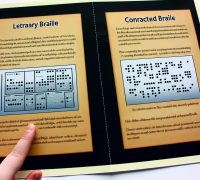Introduction to Braille Education
Braille is an essential literacy system that has played a pivotal role in the education and empowerment of blind and visually impaired individuals since its inception by Louis Braille in the 19th century. This tactile writing system utilizes raised dots arranged in a cell of six dots to represent letters, numbers, and punctuation marks, allowing individuals to read through touch. Teaching Braille to blind children is not merely about imparting the mechanics of a communication system; it is a comprehensive educational journey that involves specialized methods, innovative technologies, and a supportive network, all contributing to the development of proficient reading and writing skills in blind individuals.
The Role of Early Intervention
The importance of introducing Braille education during the early developmental stages of a child cannot be overstated. Early intervention lays the groundwork for future literacy and cognitive development, much like learning to read print at a young age impacts literacy outcomes for sighted children. Specialists in Braille education advocate for the introduction of Braille to children as early as possible, sometimes working directly with infants to stimulate tactile learning processes. Incorporating Braille into daily activities, such as games and storytelling, helps young children become familiar with the tactile nature of Braille in a manner that is both engaging and effective. This early exposure not only facilitates smoother acquisition of more complex Braille skills as they progress through their education, but it also inspires confidence and independence from a young age.
Importance of Braille Literacy
Braille literacy is not only a tool for education but a key to independence and personal development. For blind and visually impaired children, Braille opens the door to accessing the same breadth of knowledge and information as their sighted peers. While technological solutions such as screen readers have become increasingly prevalent, Braille remains irreplaceable when it comes to understanding the nuances of spelling, grammar, and syntax. According to the American Foundation for the Blind, proficiency in Braille is indispensable for tasks like note-taking, completing mathematical operations, and music notation. Thus, Braille provides a tactile context that enhances comprehension and offers a method for acquiring tactile feedback on language use.
Instructional Methods
Teaching Braille effectively involves employing a variety of instructional methods tailored to cater to individual learning styles. A multi-sensory approach proves most effective, integrating tactile, auditory, and where possible, visual components. Educators utilize tools ranging from Braille embossers that produce embossed hard copy Braille text to advanced refreshable Braille displays that serve dynamic, electronic content. The integration of hands-on activities is vital in reinforcing learning; materials such as textured books offer tangible representations of words, while labeling objects with Braille can familiarize students with real-life applications. By combining these resources within instructional frameworks, educators can ensure lessons are both accessible and engaging for each student.
Specialized Teaching Professionals
The role of specially trained educators, recognized as Teachers of the Visually Impaired (TVIs), is essential in the education of blind children. These professionals are equipped with both the skills and understanding required to teach Braille effectively. They work directly with students to develop individualized education plans (IEPs) that address specific strengths and areas for development. Continuous assessment and adaptation of teaching methods are integral components of their work, allowing for the modification of educational strategies to maintain student motivation and ensure consistent progress. By closely guiding students through their educational journey, TVIs contribute significantly to their literacy and overall educational experience.
The Use of Technology in Braille Education
Advancements in technology have revolutionized Braille education, bridging gaps that existed in previous instructional methods. Devices like electronic Braille notetakers and refreshable Braille displays have introduced new dimensions to how blind children interact with both physical and digital information. These devices allow students to access textbooks, web pages, and other digital content in a format that is conveniently usable. Technologies such as applications and online platforms offering interactive Braille lessons further enhance the learning experience, making it more accessible and engaging than traditional methods. The effective use of technology holds the promise of leveling the educational playing field for blind students, offering them unprecedented access to the same information and opportunities as their peers.
Challenges and Solutions
While Braille education is crucial, it is not without challenges. Key issues include limited resources, a dearth of qualified professionals, and scarcity of accessible Braille materials. These challenges have led to calls for more extensive collaboration among organizations dedicated to blindness services, increased funding, and policy changes aimed at broader accessibility. Innovative solutions, such as partnerships between educational institutions and organizations specializing in blindness, are underway to overcome these challenges. These collaborations aim to increase the availability of resources and trained personnel, ultimately improving the learning experience and outcomes for blind students.
Parental Involvement
The engagement of parents in the Braille education process is vital. Parents who learn Braille themselves are better equipped to provide invaluable direct support to their children at home. Participation in similar learning activities and encouragement of Braille usage in everyday contexts create an immersive environment conducive to learning. By understanding the challenges and triumphs associated with Braille literacy, parents can offer targeted support and foster an attitude of determination and self-reliance in their children.
Conclusion
In conclusion, Braille education for blind children is a multifaceted endeavor that demands a robust amalgamation of skillful educators, state-of-the-art technology, and committed family support. With an emphasis on early intervention and specialized instructional methods, along with dedicated efforts to surmount existing challenges, Braille education enables blind children to attain literacy and independence. These components work together to empower them, preparing for success in academic, personal, and future professional pursuits.

